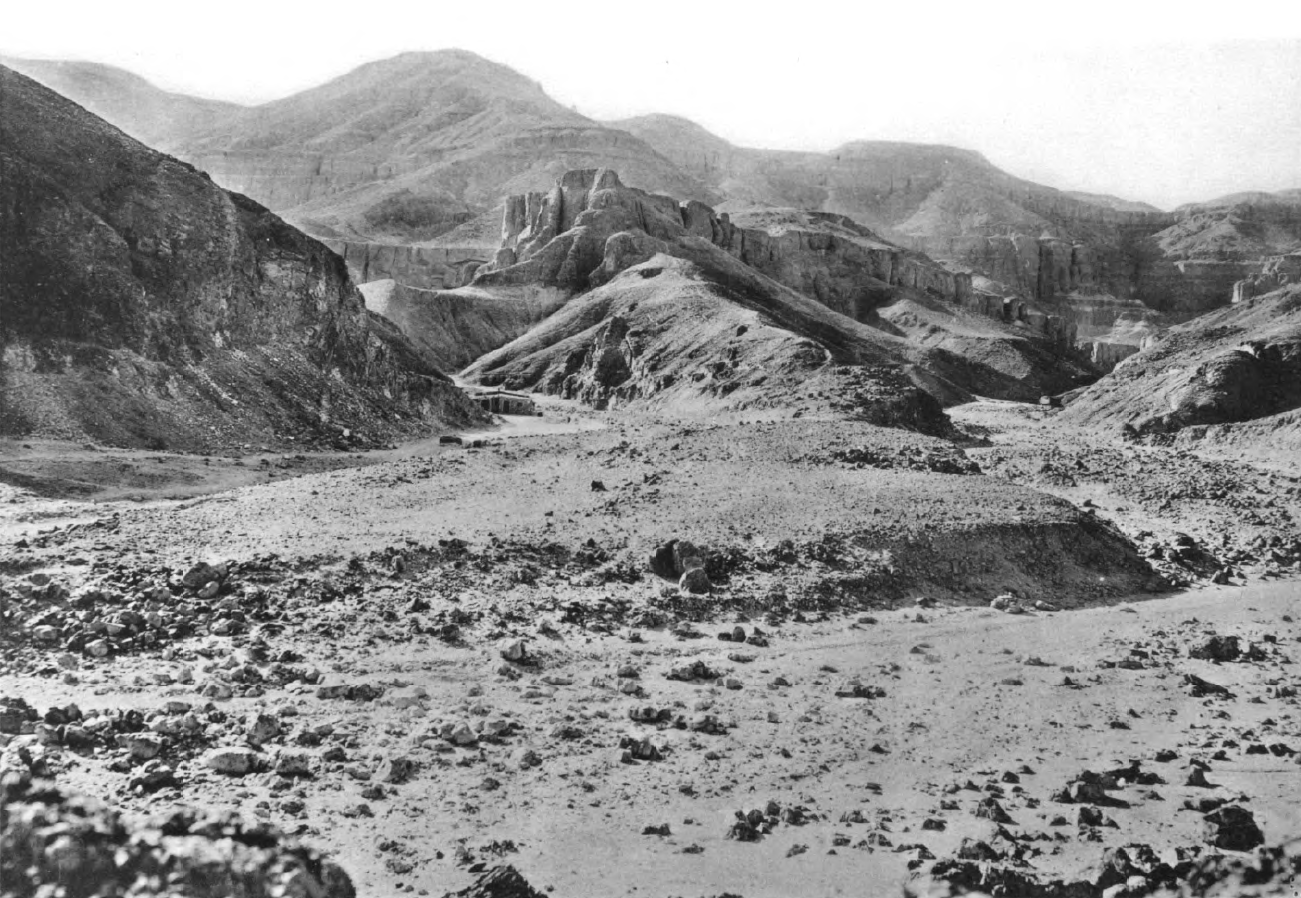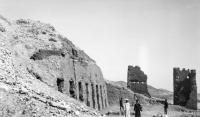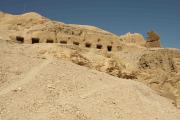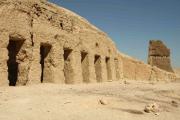Wilkinson House
About
About
Like many European travelers at the time, Wilkinson made one of the Theban tombs his home. There are many reasons why early Europeans who planned to spend any time at Thebes chose to live in a tomb: tombs were close to their work; they were quiet and away from local village noise; they were cool, even in the heat of summer, available rent-free, without a landlord, and able to be furnished to suit one’s taste. Wilkinson chose the Eighteenth Dynasty tomb of Amethu, grandfather of a very famous official, Rekhmire, both of whom served as viziers and governors of Thebes. In the later, official catalogue of Theban tombs, it is referred to as TT 83. In Wilkinson’s day, it quickly acquired the name “Qasr Wilkinson.”
Qasr Wilkinson had a standard T-shaped interior plan extending about fifteen meters into the hillside. Its entrance was cut into the back of a large courtyard lined with a row of eight rectangular columns, each 1.3 meters square with about 3 meters between. They formed a spectacular façade visible from several kilometers away. Wilkinson had the court, which measured three meters deep and 26 meters wide, roofed over with reeds and palm fronds to provide shade, and furnished it with comfortable chairs and tables. Tea there was considered a highly desirable way to spend an afternoon. The breathtaking view it offered of Thebes and the Nile Valley was remarked upon by nearly all of Wilkinson’s many visitors. Two mud brick towers, one at each end of the courtyard, offered observation platforms. The Egyptologist John Wilson described the view as he saw it in the 1950s. It was little different from that seen by Wilkinson’s Nineteenth Century visitors.
"Of all possible locations at Thebes, Wilkinson had chosen the most thrilling. Straight down, he looked upon the tawny desert, filled with the tumble rubbish of ancient tombs. Just below him was the Ramesseum, from which Belzoni had snatched the colossal head. Over there were the twin statues which Westerners call the Colossi of Memnon, as well as the great sprawling temple of Medinet Habu. Farther away began the black land watered by the inundation, with its fields of grain and palm trees. Then the ever-changing, ever-interesting Nile cut its pulsing course across the land. On the far side of the river were to be seen the columns of Luxor temple and the soaring obelisks of mighty Karnak. In the distance the desert hills reared into three marked peaks in the southeast. It was a panorama of never-ending fascination, a different color at every hour of the day." (John Wilson)
A plan of Qasr Wilkinson, drawn by Robert Hay in the 1820s, shows a thoughtful and comfortable layout, described by the modern historian Jason Thompson, one of the few who has been allowed access to Hay’s still-unpublished material in the British Museum:
"… the transverse hall behind the pillars was partitioned into sleeping quarters and a dressing room. A large wall enclosed a garden and courtyard in front. Into the wall were built a pigeon house and a tower. On the left by the way that wound up from the plain were located the anteroom, the wash house, and a place for the donkeys; the servants’ quarters were on the right. One lovely wash drawing shows a covered wooden porch extending out into the courtyard. Kalitza Hay [wife of Robert Hay] stands in one of the great rock apertures where a wooden door has been attached. A servant waits in the background. Geese mill about; vines twine up the columns; sunlight streams in." (Jason Thompson)
Over the next several years, Wilkinson used mud brick and small blocks of stone taken from nearby ancient buildings to enlarge his home, building rooms at the north and south ends of the courtyard. The extensions included bedrooms, a study, servants’ quarters, dining area, and kitchen. There was a dovecote and donkey stable nearby. For daily cooking, and heating rooms in winter, Wilkinson’s staff collected ancient sarcophagi and other wooden artifacts from nearby tombs and burned them for firewood. (One visitor complained that the ancient painted decoration gave off a terrible smell when burned.)
All that remains of Qasr Wilkinson today are a few courses of a mud-brick wall and a heap of fallen brick and stone. They are difficult to find on the rubble-strewn hillside. But the tomb of Amethu can be seen today, minus the additions Wilkinson made to it, and it can be visited with permission of the Antiquities Inspectorate. The view of Thebes and the Nile Valley from Qasr Wilkinson is still as breathtaking as it was two hundred years ago, and that alone is worth the hike up the hill.
Essay by Dr. Kent Weeks
Site History
If one asked scholars to name the important earliest works of Egyptology, most would probably begin with Champollion’s Lettre à M. Dacier (1822), which announced the decipherment of the Egyptian language. Next would come the Description de l’Egypte of the French Expedition (1809-1822); and Karl Lepsius’s Denkmaler aus Aegypten und Aethiopien (1849-59), which recorded many of Egypt’s principal monuments and allowed Europeans to see them accurately for the first time.
But equally high on the list should come the multi-volume work by John Gardner Wilkinson, The Manners and Customs of the Ancient Egyptians. The product of twelve years of living in Egypt, studying and recording its monuments, Wilkinson dealt with the lives of Egyptians, their homes and labors, costumes and diet. He showed for the first time the potential of Egyptian funerary art and architecture for the study of all classes of Egyptian society. The book’s first three volumes appeared in 1837 and were an instant and popular success. They would go through numerous printings (two additional volumes appeared in 1841), and have remained in print ever since, serving as the starting point for many studies of ancient culture. Equally important, the book encouraged further documentation of Egyptian monuments and in the process helped change the common view among Europeans that Egyptians were almost exclusively preoccupied with death and the Afterlife. For his work Wilkinson was knighted in 1839, and is considered by many the founder of British Egyptology.
After several years spent visiting and digging Egyptian sites from the Delta through Nubia and along the Red Sea, Wilkinson settled at Thebes in 1826. Here, he explored and numbered the 17 tombs then visible in the Valley of the Kings. (His tomb numbering system continues to be used today). Wilkinson left Thebes in 1833 and moved to England, returning only occasionally to Luxor after that. His final visit was in 1855. He died in 1875.
After Wilkinson’s departure, Qasr Wilkinson stood empty only briefly. Its comfortable facilities and, especially, its view, made it a desirable residence. A local Qurnawi (so the residents of the Theban hillside village of Qurna are called) named Awad (also Auad, c 1763-1868), managed the residence, and charged each visitor a rent of 15 piasteres a month. Several Egyptologists lived there over the next few years: Robert Hay (1799-1863), Edward William Lane (1801-1876), Richard Lepsius (1810-1884), Edouard Naville (1844-1926), and James Henry Breasted (1865-1935) among them. A number of famous persons also paid calls, including Rudyard Kipling, Benjamin Disraeli, Heinrich Ibsen, and Theodore Roosevelt. There was a guestbook, begun by Lepsius in 1845 and in use until 1853, now in the Staatliche Museen zu Berlin, that lists several others. Joseph Lindon Smith (1863-1950), a well-known American copyist of Egyptian paintings, was one of the last to live there, just prior to World War I. But tastes changed, and Qasr Wilkinson’s lack of running water, electricity, and modern toilets soon overcame its romantic appeal. The house was abandoned and quickly fell into ruin.
Qasr Wilkinson was not the only tomb-residence on the Qurna hillside. In addition to those of several Qurnawis, we know of a few others near Qasr Wilkinson that were occupied by a mixed bag of Europeans, including tomb robbers and dealers as well as serious students of ancient Egyptian culture. The former included Giovanni d’Athanasi (1798-1854), also called Yanni, a grave digger, dealer, and guide; and Giorgios Triantaphyllos, (c. 1840) called Wardi, also a dealer. Both men worked occasionally for Henry Salt, who lived briefly at Thebes and amassed a huge collection that he later sold to various London museums. A certain Piccinini (we don’t know even his first name) (c. 1825) lived near Qasr Wilkinson and dealt in antiquities.
Essay by Dr. Kent Weeks
Dating
This site was used during the following period(s):
Exploration
Conservation
Conservation History
There is no information on conservation projects at Wilkinson House; the house has been destroyed.
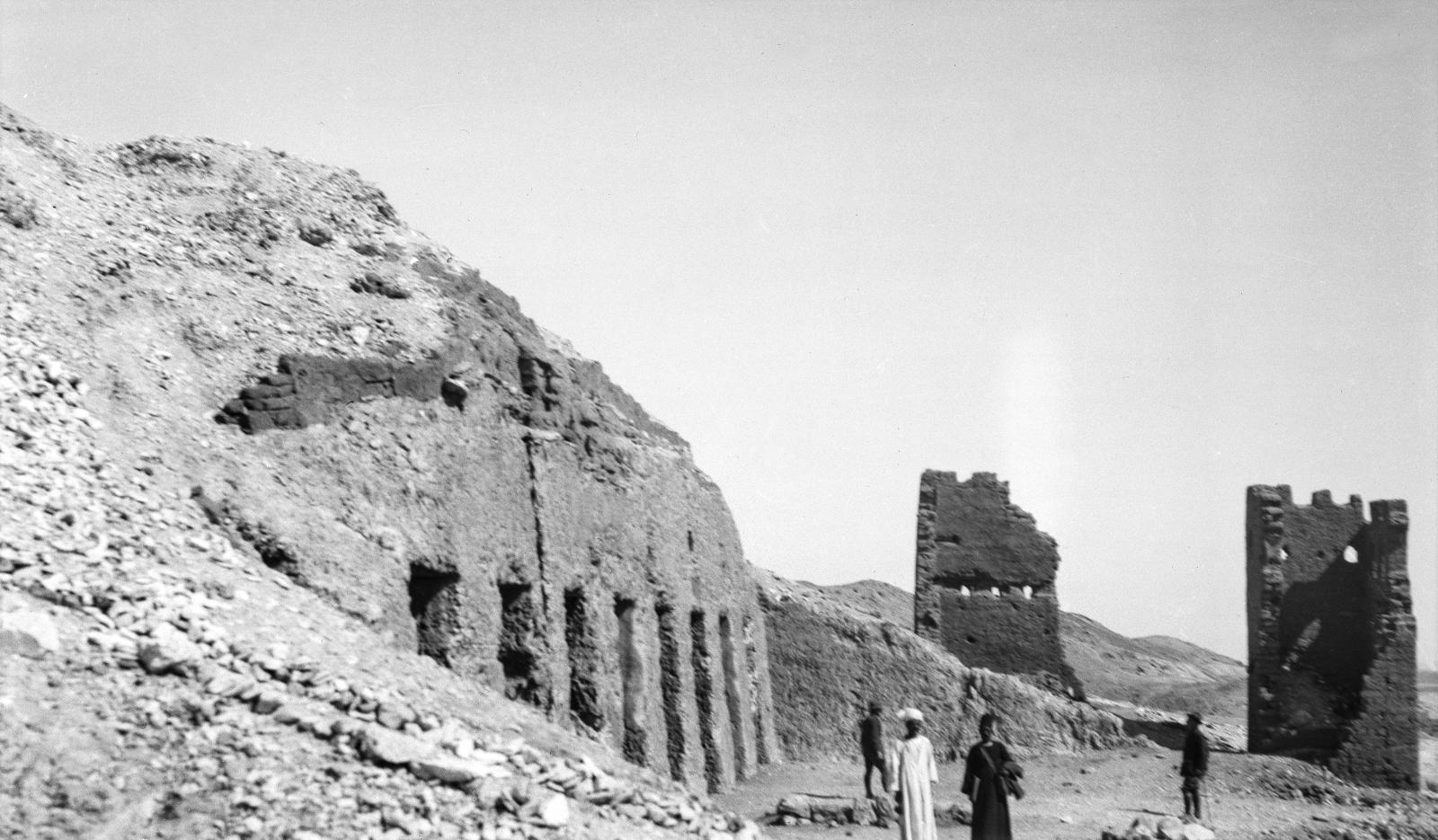


Bibliography
Bierbrier, Morris L. Who Was Who in Egyptology. Fifth revised ed. London: Egypt Exploration Society, 2019.
Romer, John. Valley of the Kings. London: Rainbird, 1981, repr., 1988; New York: Morrow, 1981. Transl. in French as: Histoire de la vallée des rois. Paris, 1991.
Thompson, Jason. Sir Gardner Wilkinson and His Circle. Austin: University of Texas Press, 1992.
Thompson, Jason. Wonderful Things: A History of Egyptology, 1: From Antiquity to 1881. Cairo: American University in Cairo Press, 2015.
Thompson, Jason. Edward William Lane, 1801-1876: The Life of a Pioneering Egyptologist and Orientalist. Cairo: American University in Cairo Press, 2010.
Thompson, Jason. Tomb-Dwelling in 19th Century Thebes: Sir Gardner Wilkinson’s House at Sheikh Abd el Qurna. KMT 7.1 (Summer, 1996): 53-59.
Wilson, John A. Signs and Wonders Upon Pharaoh: A History of American Egyptology. Chicago: University of Chicago Press, 1964.
